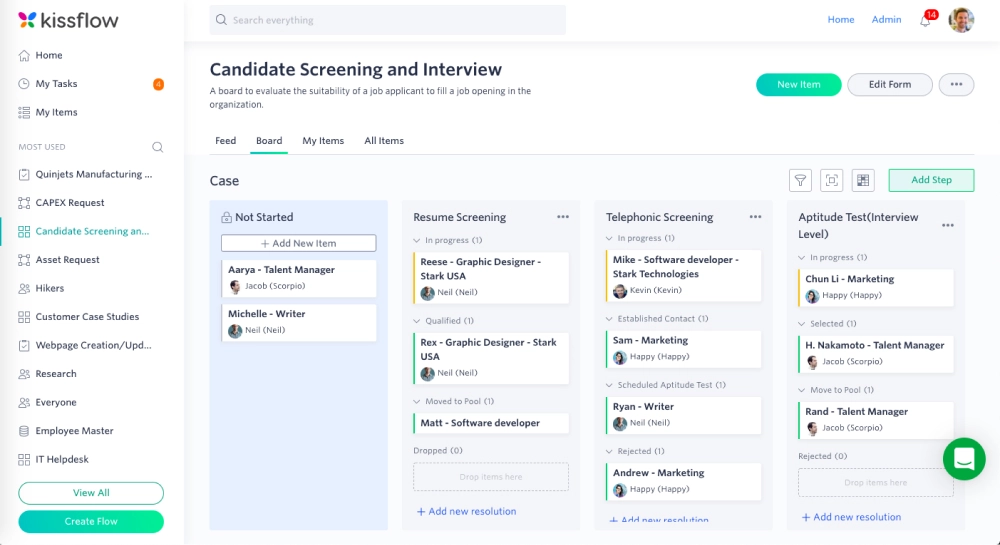Whether you’re a content creator, a marketeer, an engineer, or even an accountant, you know how important it is to get your work signed off by the right people.
But sometimes that’s easier said than done.
If your current approval process has you fighting fires, missing deadlines, and making costly mistakes, then it’s time to prioritize approval management.
In this guide I’ll walk you through the benefits of approval management, how to build a foolproof approval process, and the best approval workflow software to help you with the job.
What is approval management?
Approval management is the process of ensuring that work is reviewed and approved by the right people before it moves onto the next stage. It involves setting up a clear and structured approval process, with different review steps and different stakeholders involved along the way.
With a clearly defined approval process in place, you’ll make sure that your work meets all the necessary requirements – whether that’s tone of voice, alignment with organizational goals, legal compliance, or budgets.
Approval management is important for pretty much every team in every company. Let’s take a look at some examples.
Manage every approval in one place
Request approval without sending a single email with Filestage.
Approval management for design teams
Whether you’re working on designs for a webpage, a social media ad, new packaging, or even just presentation slides, chances are you need to get sign off from a fair few stakeholders. A well-managed design approval process helps to keep everything moving forward.
Here’s an example of an organized design approval workflow:
- Approval step one: creative director
- Approval step two: marketing team
- Approval step three: legal team
- Approval step four: client
Approval management for marketing teams
Getting approval on your marketing activity can be tricky, with multiple stakeholders, conflicting opinions, and round after round of feedback. It doesn’t matter if you’re working on a simple social media post or a cross-channel marketing campaign – the same challenges are pretty much always there.
But an organized approach streamlines, simplifies, and speeds up the marketing approval process.
Here’s an example of a well-structured marketing approval workflow:
- Approval step one: copy and design
- Approval step two: brand
- Approval step three: social media
- Approval step four: legal
- Approval step five: client
Approval management for product teams
Getting a new product design signed off is rarely easy. You have to jump through multiple hoops before you can start to manufacture the product, collecting extensive feedback to make sure it meets the project requirements and customer needs.
After all, spotting a problem down the line would be incredibly frustrating. Not to mention costly!
A thorough and well-documented process will optimize your approval management, so you can rest easy knowing that you’ve covered all bases.
Here’s one example of an effective product approval process:
- Approval step one: project manager
- Approval step two: engineers
- Approval step three: customer service
- Approval step four: marketing
- Approval step five: executive team
Why is approval management important for organizations?
There are a whole host of reasons why approval management is important for businesses. Let’s take a look at the main benefits of having an approval management process in place.
Helps you finish projects faster and meet deadlines
Without good approval processes in place, trying to get your work signed off can take forever. In fact, did you know that in creative industries, the average approval process takes eight days from start to finish? That’s a long time, especially when you’re working to tight deadlines.
Approval management helps you to get on top of your approval process and streamline how things are done. By clearly defining who needs to be involved in the process, outlining the different review steps, and sending out your approval requests with clear due dates, you’ll be able to finish projects with more efficiency, and meet every deadline from here on out.
Boosts productivity
Our report on The State of Creative Collaboration in 2023 found that waiting for feedback and chasing people for approval are the two biggest problems slowing teams down in the creative process. And let’s face it, the task of chasing every file that’s pending approval is not an efficient use of time, no matter your line of work.
With an approval management process in place – and the help of approval management software – you can save time by eliminating those monotonous manual tasks. Which means your team can focus their time and energy on more productive (and more enjoyable) parts of the job.
Improves communication and collaboration
When your approval process is all over the place, it can cause confusion and uncertainty. Not just for you and your team, but for your stakeholders too. This can lead to delays, misunderstandings, and even unnecessary conflicts.
Approval workflow management keeps everyone on the same page. Everyone knows what needs to be done, who’s responsible for what, and when approval decisions are due. This improves communication and collaboration, as well as accountability between stakeholders. And that means a more positive working environment, and better outcomes too!
Results in higher quality work
Without approval management, the right people might not be consulted. Errors and inconsistencies can easily slip through the net, and ultimately the final product won’t live up to its full potential.
With a thorough and consistent approach to getting work approved, the right stakeholders are brought together to give feedback. And since an array of experts will have scrutinized your work, you can be confident that it meets the highest quality standards.
An approval process also holds people accountable, encouraging everyone to take their role seriously and provide feedback (and eventually approval) with care.
How to build an approval workflow into your team’s work week
Ready to put approval management into practice? Here are five top tips to help you build an approval workflow into your team’s work week.
- Identify which tasks require an approval process
- Figure out who needs to be involved
- Outline the stages your work needs to go through
- Document the process and share it with relevant stakeholders
- Use approval workflow software
Manage every approval in one place
Request approval without sending a single email with Filestage.
1. Identify which tasks require an approval process
First things first, identify the processes in your department or organization that require approvals. This could be anything from approving project proposals and reviewing content to signing off budgets and expenses.
2. Figure out who needs to be involved
Next, work out who needs to be involved in the approval process. Different projects will require different stakeholders to be involved, so figure this out before you go any further. Adding stakeholders to the process at the last minute can slow things down – which is downright annoying when you’re so close to getting sign off! So getting this sorted from the get-go will save you that headache.
Don’t fall into the trap of involving too many approvers, though. Streamline your list as much as possible, as the fewer people involved, the quicker you’ll get work approved!
3. Outline the stages your work needs to go through
You’ve got your list of approvers. Now to work out the order of sign off.
Think logically about how you want to structure the process. For example, if you’re client-facing, then it doesn’t make sense to send your client an approval request before all your internal teams have had their say. Why? Because if any additional changes are suggested and made, you’ll end up having to go back to your client again.
Remember, we’re trying to streamline the process, not add in extra stages!
Break it down into a series of steps. It might look something like this:
- Step one: immediate team
- Step two: wider team
- Step three: senior management
- Step four: client
Set due dates, and make it clear exactly what you need from each set of approvers at each step. Are they giving their approval on tone of voice? Alignment with company goals? Compliance? Budget?
Outlining what you need will help stakeholders focus their attention – and prevent them from providing feedback on areas they’re not an expert in!
4. Document the process and share it with relevant stakeholders
Make sure everyone in your team or business is aware of the approval workflow and understands their role in the process. Documenting it as an official process boosts transparency and helps hold everyone accountable. They can see where they fit into the bigger picture, and how their contributions impact the project as a whole.
The result? Fewer delays. No more chasing. And a sense of everyone working towards the same goals.
5. Use approval workflow software
The best way to build an approval workflow into your team’s work week is with the help of approval management software like Filestage. This way, you keep the entire approval process in one place, making it easy to keep track of pending approvals and what’s been signed off.
More on this in a moment!
Can you use automated approval workflows?
Absolutely!
By using approval management software like Filestage, you and your team will benefit from automated approval workflows that take the concept of streamlining to another level.
With Filestage, you can use automated approval workflows to:
- Send approval request reminders without lifting a finger
- Assign due dates automatically to get approval on time
- Update file statuses when reviewers request changes
- Start the next review step the moment a file is approved
Those monotonous manual tasks will soon be a thing of the past!
The four best approval management software on the market
Here are the four best approval workflow software for managing your approval process. Each has its own unique features and function, so the best one for you will depend on the business processes you’re looking to optimize.
1. Filestage – Best for file approval management

Filestage is an approval management tool that makes file approval faster, easier, and more consistent across your whole organization. From documents and designs to videos and interactive HTML, it helps you get your work approved and published, without delay.
Key features:
- Project dashboards – to manage all files, feedback, and stakeholders in one place
- Folders – for grouping projects by topic or client
- Review steps – for involving the right people at the right stage of the process
- Templates – for repeating the same approval process
- Automations – to change review statuses and move files from one step to the next
- Due dates – to keep projects on track and help you meet deadlines
- Notifications – when people add comments or submits approval decisions
- Version history – to keep tabs on previous comments and see what’s changed
- App integration – connects with Slack, Microsoft Teams, and more
Pricing:
If you’re a small team just getting started with Filestage, you can start out with our Free plan, which includes two projects and two review steps with unlimited team members and reviewers. After that, it’s $49/month for Basic.
Manage every approval in one place
Request approval without sending a single email with Filestage.
2. Conga – Best for contract approval management

Conga is an approval workflow automation software designed to automate and streamline contract management and approval workflows. The software integrates with a variety of third-party applications, including Salesforce, Microsoft Dynamics, and DocuSign.
Key features:
- Customizable approval workflows
- Integration with third-party applications
- Analytics and reporting to track approval status
- Drag-and-drop interface
- Automated email notifications
- Audit trails
Pricing:
There’s no one-size-fits-all pricing model – prices are flexible depending on your unique requirements.
3. Tipalti Approve – Best for finance approval management

Tipalti Approve is a cloud-based approval workflow software that is particularly suited to finance teams. As well as streamlining approval workflows and automating approvals for purchase orders, expense reports, and invoices, the platform also offers budget management tools. This helps businesses set spending limits and track expenses against budgets.
Key features:
- Customizable approval workflows
- Automated notifications and reminders
- Real-time tracking and insights
- Budget management tools
- Integrations with third-party accounting applications
- User-friendly interface
Pricing:
Pricing is quote-based, depending on your organization’s requirements.
4. Kissflow – Best for HR approval management

Kissflow is a simple approval workflow software for HR teams that want to design, build, and customize workflow apps. Human resources teams can drag and drop different workflow apps within this cloud-based system, including vacation requests, expense claims, and purchase requests.
Key features:
- No-code custom workflows
- Parallel, sequential, and conditional approvals
- Built for scalability
- Friendly user interface
- Real-time analytics
- Progress tracking
- Automated notifications and reminders
- Integrations with third-party applications
Pricing:
Pricing starts from $15/user per month.
Final thoughts
I hope you’ve enjoyed learning about the benefits of approval management and how to build an approval process.
If you’d like to see for yourself how Filestage could help with your approval workflow, you can start a free trial here →





